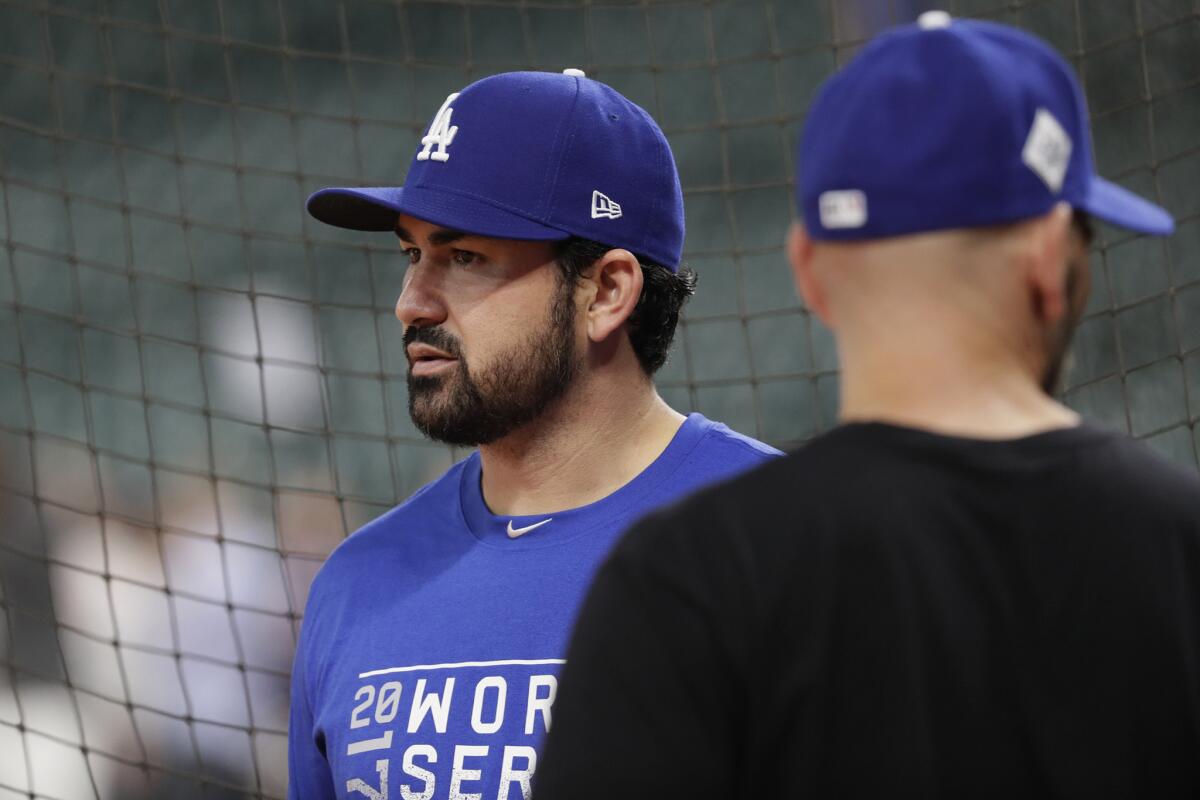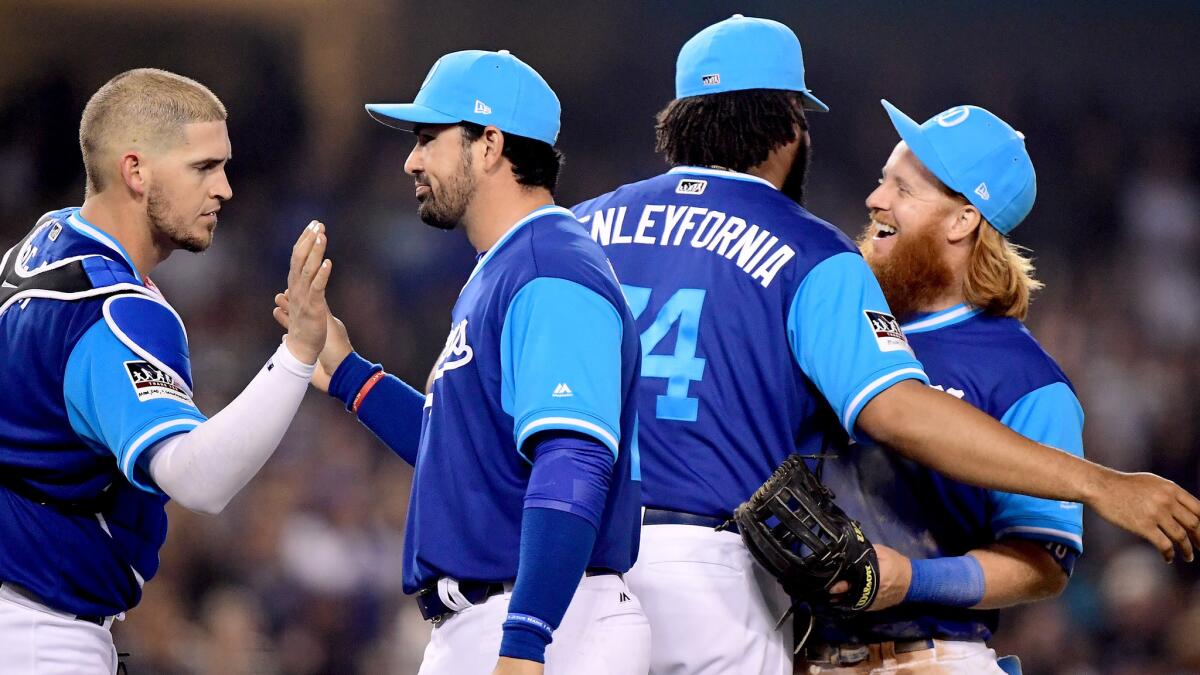A $300-million team? Don’t expect the Dodgers to have a payroll like that again

- Share via
If the acquisition of Adrian Gonzalez five years ago marked the beginning of the most extravagant era in Dodgers history, his departure last week signaled its end.
The Dodgers have paid a record amount in luxury taxes the past five years, nearly $150 million. They will spend again, but not like they have in recent seasons.
The 110th page of baseball’s collective bargaining agreement explains why: Any team with a payroll that exceeds the designated “second surcharge threshold” will not only pay a heavy monetary fine, but will also have its top pick in the amateur draft moved back 10 places.
Considering how the Dodgers have preached the importance of a robust player-development system, this is a penalty they will do everything to avoid.
Limiting their payroll for the upcoming season under the $197-million base luxury threshold will increase their financial flexibility — they will initially be spared the penalties applied to repeat offenders of competitive balance regulations — but there is a ceiling to how much they will be able to spend in the future as well.
The second surcharge threshold will be $246 million in 2019. Go over that and a team’s draft position will be compromised. The limit will increase by only $2 million in each of the next two seasons.
This isn’t a salary cap, but it’s close.
Generally speaking, owners don’t like paying luxury taxes and the Dodgers paid $36.2 million in taxes this past season, which was more than double any other team. Also, baseball operations departments don’t like compromising their top draft picks.
The potential penalties here align those interests.
So don’t expect the Dodgers to field another $300-million team like they did two seasons ago. That much is clear.
The question is where the Dodgers will exercise restraint.
As much as Andrew Friedman’s front office has taken a quantity-over-quality approach in constructing the 40-man roster, the franchise still recognizes the value of stars. The $80 million they invested to re-sign closer Kenley Jansen a year ago is evidence of that.
A quarter-billion dollars might not buy what it used to, but that should still be enough for the Dodgers to retain their best players and pursue high-end alternatives.
The difference should be on the margins.
In the contract swap performed with the Atlanta Braves last week, the Dodgers’ free spending wasn’t marked by Gonzalez, but a couple of the players with whom he was packaged. In exchange for taking on what remained of Matt Kemp’s contract, the Dodgers unloaded Gonzalez, Scott Kazmir, Brandon McCarthy and Charlie Culberson.
Gonzalez used to be a necessity — a middle-of-the-order hitter, consistent run producer and community ambassador. McCarthy and Kazmir were the luxuries — a couple of injury-prone, $48-million lottery tickets.
This is where the Dodgers may have to modify their approach.

Reflect on McCarthy’s and Kazmir’s tenures with the Dodgers and most people will think about how much they were paid or how many starts they missed. What is often forgotten is that bad contracts to key players are what ruin teams, not bad contracts to peripheral players.
McCarthy and Kazmir were never expected to anchor the Dodgers’ rotation. Their absences were easily manageable.
If you viewed them as depth, which is pretty much what they were, they were merely expensive options. The typical back-end starter is either a journeyman or a youngster still trying to establish himself in the major leagues.
McCarthy and Kazmir came to the Dodgers with reasonably successful track records.
The performances didn’t justify their salaries, but they did contribute. McCarthy started 16 games last season and posted a respectable 3.98 earned-run average. Kazmir started 29 the previous season and won 10 games.
The Dodgers will have to replace these starts, and will most likely have to do so from within their organization, because another deal like McCarthy’s could turn a first-round selection into the equivalent of a second-round pick.
The foundation of their rotation is in place with Clayton Kershaw, Rich Hill, Alex Wood and Kenta Maeda. The back end, as well as the depth, will have to be provided not by another McCarthy, Kazmir or Josh Beckett, but instead by homegrown players such as Walker Buehler, Ross Stripling and Brock Stewart.

The same applies to the position players. In previous seasons, the likes of Andre Ethier and Carl Crawford periodically rose from their figurative deathbeds and demonstrated qualities that earned them multi-year contracts. The Dodgers won’t be able to call on Ethier next season to provide them with professional-grade at-bats during the postseason. They will have to count on the likes of Alex Verdugo, Andrew Toles and Joc Pederson.
The roster will be leaner. There will be fewer contracts that fans will complain about. But there will also be more risk.
The Dodgers said they would move in this direction from the time their current owners purchased the franchise. They prioritized scouting and player development, emphasizing the importance of a self-sustaining organization that could produce its next generation of major leaguers.
That future is here.
Follow Dylan Hernandez on Twitter @dylanohernandez
More to Read
Go beyond the scoreboard
Get the latest on L.A.'s teams in the daily Sports Report newsletter.
You may occasionally receive promotional content from the Los Angeles Times.










